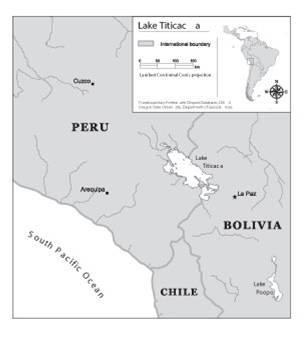Management, Protection, and Control of Lake Titicaca
| Geolocation: | -15° 47' 46.2894", -69° 22' 59.1884" |
|---|---|
| Total Watershed Population: | 2,448,790 million |
| Total Watershed Area: | 111,582 km243,081.81 mi² |
| Climate Descriptors: | Semi-arid/steppe (Köppen B-type), Arid/desert (Köppen B-type), Dry-winter |
| Predominant Land Use Descriptors: | rangeland, religious/cultural sites |
| Important Uses of Water: | Agriculture or Irrigation, Domestic/Urban Supply, Other Ecological Services |
Contents
Summary
Populations have been living around Lake Titicaca for 10,000 years, dating back to the Archaic period. The first communities appeared around Titicaca in 1,200 BC and since then have increased in population and have become more dependent on its water for their livelihood for agriculture and navigation. A series of natural occurring events took place in the 1980s which pushed the countries of Peru and Bolivia to manage the waters of Lake Titicaca in a more sustainable manner as the vulnerability of the inhabitants of the region was very high in extremely poor conditions that did not need to be exacerbated further. In the rainy seasons of 1982-3 and 1989-90, extreme droughts caused hundreds of millions of dollars in damage to the agricultural industry, both crop and animal. The years in between experienced a higher than average rainfall and culminated in the severe floods of 1986-7 causing, again, over a hundred million dollars of damage to not only the agricultural industry, but to infrastructure as well. Relations between Peru and Bolivia have always been good dating back to when they became independent nations in the 1800s. Lake Titicaca has not been a source of contention between the two states, but rather a reinforcement of their willing to cooperate with one another when their interests are mutual. The major problem; therefore, is not about conflict between Bolivia and Peru, but how to develop and improve the living conditions of the extremely poor populations who live with the Titicaca basin.
Natural, Historic, Economic, Regional, and Political Framework
Issues and Stakeholders
Analysis, Synthesis, and Insight
Key Questions
| Area | 111,582 km² (43,081.81 mi²) + |
| Climate | Semi-arid/steppe (Köppen B-type) +, Arid/desert (Köppen B-type) + and Dry-winter + |
| Geolocation | -15° 47' 46.2894", -69° 22' 59.1884"Latitude: -15.7961915 Longitude: -69.3831079 + |
| Land Use | rangeland + and religious/cultural sites + |
| Population | 2,448,790 million + |
| Water Use | Agriculture or Irrigation +, Domestic/Urban Supply + and Other Ecological Services + |
 This is a
This is a 



